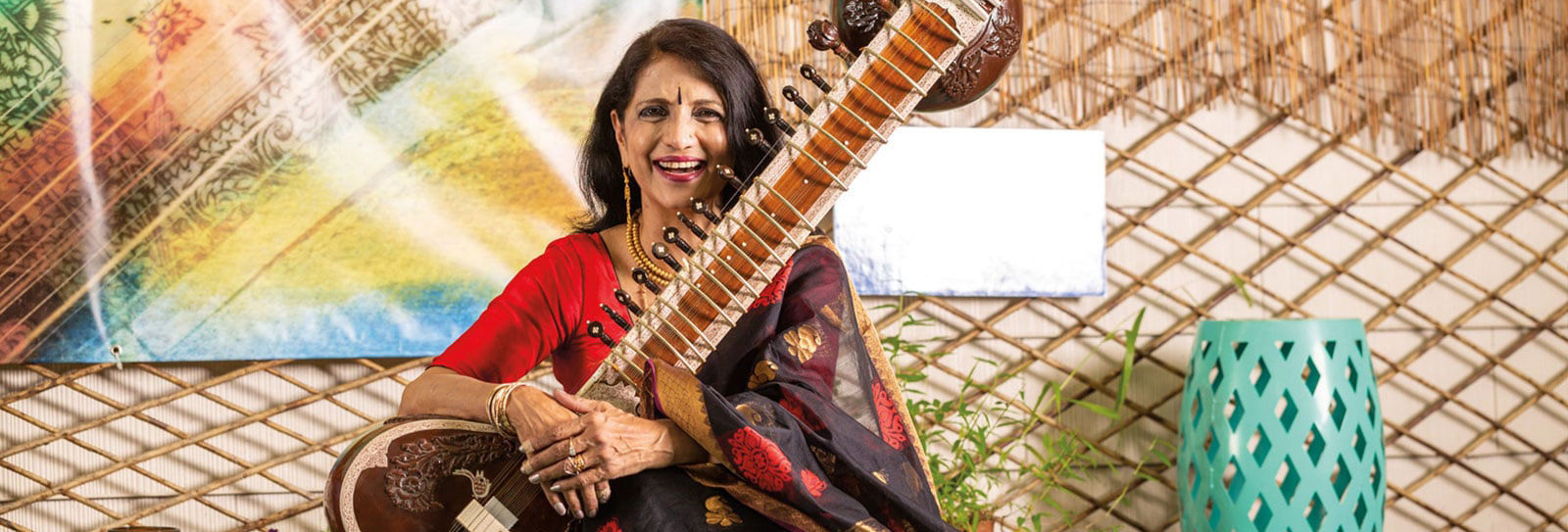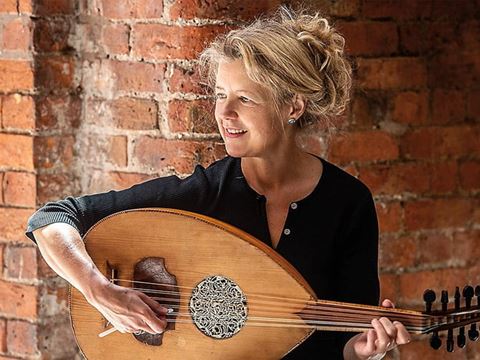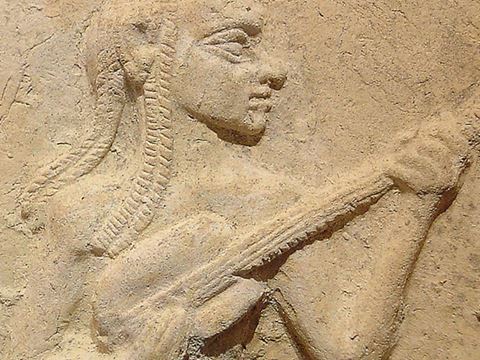
Sitar Master of Maryland
With a lifetime of training from leading sitar virtuosos, Alif Laila is one of few women to achieve international recognition with the mesmerizing instrument whose sound evokes the musical identity of the greater Indian subcontinent. She is as passionate about music as she is about encouraging other women.

In her home studio in Silver Spring, Maryland, Alif Laila’s vibrant murals and watercolor paintings adorn each wall. It’s a space she has grown into over decades, a creative refuge for living, working, meditating, painting and, most of all, playing and teaching music, all amid kaleidoscopic decor inspired by the country of her birth, Bangladesh. A virtuoso of the sitar who has earned the master musician’s title Vidushi, she steps out from the studio into a well-tended garden. There among greenery and stones, she teaches children and adults of various cultural backgrounds how to pluck and pick her beloved, long-necked, gourd-shaped instrument. Speaking about more than just the flora, Laila says hers is a garden “where the seeds of South Asia’s cultural heritage grow lusciously, thousands of miles away from home.”
She is especially passionate, she says, about encouraging young women to take up the sitar, as even today Laila stands out as one of few women in the world to achieve fame with the instrument.
“The sitar is mysterious and mesmerizing. You’re in a spell. You can’t figure out what it is,” she says, describing the sitar’s tantalizing ability to produce sounds that appeal to ears not only in the subcontinent and parts of Asia but also across the world. Beginning in the 1960s, she explains, “it was the sitar that opened the doors to meditation [and] yoga.”
Often compared to an expanded version of a classical lute—to which it is distantly related—the sitar’s distinctively chimeric sound comes from its combination of plucked strings with sympathetically tuned, reverberating drone strings. Paired with a tabla (hand drum) to “complete the essence of the music,” the sitar’s sound evokes history and spirituality. Laila explains that the sitar has no one place of origin. Rather, it “developed over eras in which national borders were not so defined as today,” amid lands that are today Turkey, Iran, Afghanistan, Pakistan, India and Bangladesh.
“I strongly believe that through the sitar, I’m spreading universal peace and unity,” Laila says, mentioning that the sitar’s popularity crosses not only countries but religions too, as it is widely popular in South Asia among Muslims, Hindus and Buddhists alike.

Over more than three decades, Laila has performed at concert halls including the Bangladesh National Museum in her native Dhaka, the Kerala Fine Arts Society in Cochin, India, the headquarters of the United Nations Educational, Scientific and Cultural Organization (unesco) in Paris, South Bank Centre in London, and dozens of other venues from Kuwait to the us, from performance halls to houses of worship and community centers—anywhere cultural diversity is celebrated. “No borders,” she says.
In 2013 Laila performed at the prestigious Kennedy Center in Washington, dc, to commemorate the 150th anniversary of the birth of Swami Vivekananda, a 19th-century Hindu monk and proponent of interfaith dialog. Four years later she was invited back to give an audiovisual concert that projected her watercolors around her, the colors dancing and moving along with her raga, a Sanskrit word for the form of music she performs and one that refers both to passion and color.
The following year she became the first female sitarist to perform at Dhaka’s historic Shahid Minar, a national monument to those who sacrificed their lives during the independence movement that led to Bangladesh’s founding in 1971. In 2015 she opened her music school, Sitar Niketan (abode of sitar), with the aim of preserving musical traditions of South Asia.
Laila recognizes her journey as a musician, and her ascent in the world of master sitarists—especially as a woman—has been pioneering. And yet she found her way.
“I strongly believe that through the sitar I’m spreading universal peace and unity.”
—Alif Laila
It was her late mother, Laila says, who inspired her. Her mother had wanted to learn the instrument herself when she was growing up in Kolkata, India. But in the 1930s and 1940s, it was considered inappropriate for a respectable young Muslim woman to perform in public as an instrumentalist, and a woman could not be taught privately by a man. Dancing and singing were more culturally acceptable for women, and her mother participated in this, s did Laila, when she was a child. Still both wanted to learn the sitar even though it was thought to be a man’s instrument that required male strength to master.
“I started my music training with singing, but I was very shy, and my voice did not have a wide range. So, my mother encouraged me to try the sitar, and that did the magic,” she says, remembering her mother’s gentle support. Her father, initially, was not as enthusiastic, but he did not bar her way.
One day when Laila was 17, she told her father she was going to visit an aunt in Kolkata. She returned home to Dhaka a few days later carrying a sitar. She knew it would be difficult to master and that support would be infrequent. She also knew that, when she married, the duties expected of her as a wife and mother would be expected to remain her priority.

“It is well known that a male sitar player has to be supported,” she says. “But it doesn’t work that way for a woman. Career, marriage and childbirth all get in the way. You will not be able to get up early in the morning and start practicing or do yoga and meditation. You have to take care of the house and feed the children.”
Laila was fortunate to find a master instructor in Dhaka, the late Ustad Mir Qasem Khan, nephew of noted sitarist and composer Ustad Allaudin Khan, who was often referred to as a “guru of genius.” (Ustad is a title for a male master musician in the region’s Muslim tradition; Pandit is its Hindu equivalent.) Her first teacher’s cousin, Annapurna Devi, later became a renowned player of the surbahar (bass sitar) who married the world’s best-known sitar player of all time, Pandit Ravi Shankar. In this way, Laila traces her musical pedigree through generations of masters in what she explains is “solely an aural tradition that cannot be written to be portrayed in its true form.”
After graduating from the College of Fine Arts in Dhaka in 1980, Laila moved first to Kuwait and in 1988 to Maryland. She raised two children and continued her music education with teachers who taught from the repertoire of the late Pandit Nikhil Banerjee—also a student of Allaudin Khan, and Banerjee is recognized today as one of the greatest sitarists of the 20th century.
Through a mutual friend, Indian tabla player Pandit Anindo Chatterjee, Laila had a chance to meet her icon, the late Shankar. The Indian sitarist had shot to global fame in 1971, when his accounts of the plight of millions in Bangladesh inspired one of his friends and students, George Harrison of the Beatles, to produce a pair of benefit concerts to raise funds for refugees: “The Concert for Bangladesh” became a bestselling live album and a precedent for half a century of charitable concerts by popular musicians. Earlier, with the Beatles, Harrison had featured the sitar in his songs “Norwegian Wood” and “Within You Without You.” Since then, the sitar has become an adjunct instrument for many popular musicians in the West, from The Mamas and the Papas and The Rolling Stones to Guns N’ Roses, Thievery Corporation and Odesza.
“Ravi Shankar opened up the doors of Indian classical music to the whole world,” Laila says. Meeting maestros “who are like stars” is always inspiring, she says, but meeting Shankar felt like an “encounter with an entire constellation!”
As an instrument, the sitar is analogous to the medieval Persian three-stringed sehtaar and the South Indian veena. Usually constructed from teak wood, its long, hollow neck is strung with 21, 22 or 23 strings: Seven are top strings, which are plucked, and the remainder are the sympathetic “bottom strings.” With front and side tuning pegs and 20 movable frets, it measures about 1.2 meters and weighs in at just over 4 kilograms.
Ethnomusicologist Max Katz, associate music professor at the College of William & Mary in Williamsburg, Virginia, says the sitar became an integral part of North Indian royal court music starting in the late 12th century, and it endured all the way through the rise of British occupation in the 19th century, reaching its apogee during the Mughal era.
When India’s first music schools began opening in the late 1800s, Katz says many of its students were women.
“A lot has changed over the last 150 years,” says Katz. “In the early 20th century, it became a lot more common for women to learn sitar. It was part of a shift to a new kind of national consciousness. But Indian classical music was very awkward to perform because the actual origins of Hindustani music were in royal courts. It was designed for elite entertainment, and the people who played that music were hereditary musicians—and all male.”
“[The sitar] was designed for elite entertainment, and the people who played that music were hereditary musicians—and all male.”
—Max Katz

Women did have a role, however, as singers and dancers, though women were not encouraged to perform for anyone outside their immediate family. Even today there remain few international female superstars of Indian music.
One of the few pioneering women in the contemporary era was Devi, who passed away in 2018 at the age of 91. Another female great from the subcontinent is Shankar’s daughter Anoushka, who in 2016 was nominated for a sixth Grammy in the category Best World Music Album for Land of Gold.
“Even today, a modern free-spirited woman cannot be a true sitar player,” Laila says. “You have to devote yourself like a monk to be able to master the sitar to a certain level, let alone perform professionally.”
It was only after Laila’s two sons were grown, she says, that she felt she could turn her fullest attention back to the sitar. “Fortunately, things worked out,” she says.
Since 2000 Laila has produced 10 albums, among which both Devotion and Inner Voice were recorded with Chatterjee on tabla. Later works include Amma (a tribute to Laila’s mother) and I Am A River, a fusion album of Indian classical and jazz ragas with help from saxophonist Bernhard Ullrich. Her most recent album, Ekavali, means “the connecting thread” in Sanskrit. All but one of her album covers are illustrated with her own paintings.
As a career performer, Laila understands her journey has been as much about patience and focus as it has been about sacrifice.
“You need a healthy lifestyle in order to practice three or four hours a day. It’s hard for a woman to physically carry around a sitar while touring internationally. You need to be strong. And if you’re not, that also affects your mental strength,” she says.
The burden is a joyful one, she says, and she aims to continue until she can no longer pluck. And even then, she will listen—and encourage other women to take up a sitar and practice until they, too, can improvise a raga.
“It took me a whole lifetime, and some people don’t have the patience,” she says. “You have to give it your whole mind and your body. You have to breathe it in. And you have to believe in yourself.”
About the Author

Eric Kayne
Photographer Eric Kayne is a native of San Antonio, Texas. He earned a Bachelor of Arts in studio art from the University of Texas at Austin and a Master of Arts in photography from Ohio University. He has worked for numerous publications including the Houston Chronicle. He lives in Washington, DC.
Larry Luxner
Larry Luxner is news editor of The Washington Diplomat and a freelance journalist and photographer.
You may also be interested in...

Nass El Ghiwane: Folk Musicians That Changed Morocco
Arts
This group of five young folk musicians became the voice of Morocco in the 1960s and beyond. Martin Scorsese called them “the Rolling Stones of North Africa,” but to Moroccans they were the sound of an entire generation in a charged moment of global pop culture.
A Personal Exploration of the `ud: A Conversation With Rachel Beckles Willson
Arts
Entranced as much by its sound as by its centuries of history, in 2010 Rachel Beckles Willson started playing the `ud (oud), building enough skill to start performing on the instrument. She also became curious about its origins.
Lute and Lyres' Legacy: Echoes in The Oud Instrument and Beyond
Arts
History
For more than 4,000 years. people have adopted, adapted and adjusted the lute, resulting in its countless variations. Along the way. some innovations have proved both consequential and simple.